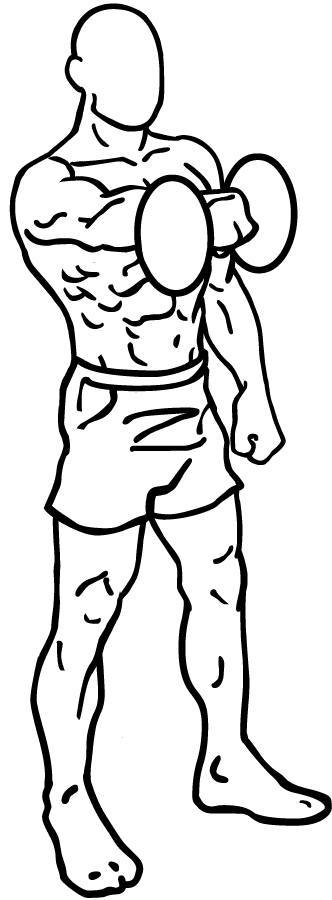Last Updated on September 30, 2014
Front raises are a fundamental exercise that targets the shoulders, chest, and forearms. This simple yet highly effective movement helps build strength and muscle definition, making it a staple in many fitness routines. In this guide, we’ll break down everything you need to know about front raises, including their benefits, variations, tips for proper form, and more.
What Are Front Raises?
Front raises are a shoulder isolation exercise typically performed with dumbbells, although other equipment like resistance bands or cables can also be used. The movement focuses on the anterior deltoids (the front part of the shoulder), but it also engages the chest and forearm muscles, making it a versatile upper-body workout.
This exercise is excellent for developing shoulder strength and definition, enhancing posture, and improving stability and balance. Whether you are a beginner or an advanced athlete, front raises can be modified to suit your fitness level.
Muscles Worked During Front Raises
While the primary target of front raises is the anterior deltoids, several other muscle groups are involved to stabilize and assist during the movement:
- Anterior Deltoids: These are the primary muscles activated. They help lift the arm forward, creating shoulder flexion.
- Pectoralis Major: The chest muscles, especially the upper portion, are engaged to provide support and stability during the raise.
- Biceps Brachii: The biceps play a role in stabilizing the arm as it lifts.
- Forearm Muscles: These help grip and stabilize the dumbbells throughout the movement.
- Core Muscles: Engaging the core helps maintain balance and a stable posture, preventing swaying or arching of the lower back.
How to Perform Front Raises Correctly
Proper form is crucial for maximizing the effectiveness of front raises and minimizing the risk of injury. Follow these steps for a safe and effective workout:
- Setup: Stand with your feet shoulder-width apart, your abs engaged, and your knees slightly bent. This stance helps distribute your weight evenly and stabilizes your body during the exercise.
- Grip: Hold a dumbbell in each hand with your palms facing down (pronated grip). The dumbbells should start at waist height, resting against your thighs.
- Raise: Lift your left arm in front of you while keeping your elbow slightly bent. Your arm should move in a controlled, smooth motion until it is parallel with the floor, in line with your shoulder. Make sure not to swing the weight or use momentum.
- Pause: Hold this position for a brief moment to engage the muscles fully.
- Lower: Slowly lower your arm back to the starting position at your waist. Maintain control to prevent the dumbbell from dropping quickly, as this could strain your shoulder joint.
- Repeat: Perform the same motion with your right arm.
Note: You can also perform front raises with both arms simultaneously if you prefer, but ensure your form remains intact.
Tips for Optimal Performance
- Warm-Up: Always begin with a warm-up, focusing on shoulder mobility exercises like arm circles, shoulder dislocations with a resistance band, and light stretches. This prepares the muscles and joints for the movement.
- Control the Motion: Avoid swinging the weights or using momentum. The movement should be controlled and steady, focusing on muscle contraction rather than speed.
- Breathe Properly: Inhale as you lift the weight and exhale as you lower it. Proper breathing helps maintain stability and reduces the risk of straining your muscles.
- Use the Right Weight: Start with lighter weights if you’re a beginner. It’s better to use a manageable weight to ensure proper form and prevent injuries.
- Engage Your Core: Keeping your abs tight will help stabilize your torso, preventing any unwanted movement or strain on your lower back.
- Avoid Locking Your Elbows: Keep a slight bend in your elbows to reduce stress on your joints and target your muscles more effectively.
Common Mistakes to Avoid
Front raises are a simple exercise, but there are several common mistakes that can limit their effectiveness or cause injury:
- Swinging the Weights: Using momentum instead of muscle control reduces the effectiveness of the exercise and can strain your shoulder joints.
- Lifting Too High: Raising the dumbbells above shoulder level can put unnecessary stress on the rotator cuff. Stop when your arms are parallel to the floor.
- Arching the Lower Back: Keep your core engaged and your spine neutral. Arching your back may lead to discomfort or injury over time.
- Using Too Much Weight: If you cannot perform the movement with controlled form, reduce the weight. Lifting too heavy can compromise your shoulder health.
Front Raise Variations for Enhanced Gains
To keep your workouts fresh and target different muscle fibers, try these variations:
- Alternating Dumbbell Front Raise: Instead of lifting both arms simultaneously, alternate arms. This can improve focus and ensure each shoulder works independently.
- Barbell Front Raise: Holding a barbell with both hands, lift it straight in front of you. This variation allows you to lift heavier weights and challenges your stability.
- Cable Front Raise: Using a cable machine, set the pulley at the lowest position. Grab the handle with one hand and raise it to shoulder height. This adds constant tension throughout the movement, increasing muscle engagement.
- Plate Front Raise: Hold a weight plate with both hands in front of your body. Lift the plate to shoulder height. This variation offers a different grip and challenges the chest and forearms.
- Resistance Band Front Raise: Step on a resistance band and hold the handles. This is a great option for those who prefer a lower-impact exercise or need a portable workout solution.
Who Should Avoid Front Raises?
While front raises are generally safe, there are some scenarios where this exercise may not be suitable:
- Shoulder Injuries: If you have a history of shoulder issues, such as rotator cuff injuries or impingement, consult with a healthcare professional or physical therapist before attempting front raises. They may recommend modifications or alternative exercises that are safer for your condition.
- Elbow or Wrist Pain: Front raises can exacerbate pain in the elbows or wrists. If you experience discomfort during the exercise, stop immediately and seek advice from a professional.
Benefits of Adding Front Raises to Your Routine
- Improved Shoulder Strength: The primary benefit of front raises is building strong, well-defined shoulders. Strong shoulders not only look great but are essential for many daily activities and sports.
- Increased Upper Body Stability: By strengthening the anterior deltoids and stabilizer muscles, front raises help improve balance and stability, reducing the risk of injury.
- Enhanced Posture: Strengthening the shoulder muscles can correct imbalances that lead to poor posture, especially if you spend long hours sitting or working at a desk.
- Versatility: Front raises can be modified with various equipment, making them suitable for all fitness levels and goals. Whether you use dumbbells, cables, or resistance bands, front raises can be easily adapted to your workout.
Incorporating Front Raises into Your Workout Routine
When planning your workout, front raises can be included in both upper body and shoulder-focused sessions. Here are a few ways to incorporate them:
- Upper Body Routine: Pair front raises with other upper body exercises like bench presses, lateral raises, or bicep curls for a comprehensive workout.
- Shoulder-Focused Day: Combine front raises with lateral raises, overhead presses, and rear delt flyes to target the entire shoulder complex.
- Supersets and Circuits: Front raises work well in supersets with other shoulder or arm exercises. For example, you can superset front raises with lateral raises for a complete deltoid workout.
Example Workout:
- Warm-Up: 10 minutes of dynamic stretches (arm circles, shoulder dislocations)
- Set 1: Dumbbell Front Raises (3 sets of 12 reps)
- Set 2: Dumbbell Lateral Raises (3 sets of 12 reps)
- Set 3: Overhead Dumbbell Press (3 sets of 10 reps)
- Cool Down: 5-10 minutes of static stretches (shoulder stretch, chest stretch)
Modifications for Beginners and Advanced Athletes
- Beginners: Start with light weights (2-5 kg) and focus on mastering the form. Aim for higher reps (12-15) to build endurance and muscle memory.
- Advanced Athletes: Increase the weight or incorporate different equipment like cables for added resistance. You can also add pauses or slow eccentric phases (lowering the weight slowly) to increase muscle tension.
Frequently Asked Questions About Front Raises
1. How often should I do front raises? You can include front raises in your workout routine 2-3 times a week, depending on your goals and overall program. Allow at least 48 hours of rest between sessions to let your muscles recover.
2. Can I perform front raises with resistance bands instead of dumbbells? Yes, resistance bands are a great alternative. They provide constant tension throughout the movement, which can be beneficial for muscle engagement and strength development.
3. Are front raises better with one arm at a time or both arms together? Both methods are effective. Alternating arms allows for greater focus on each side, while lifting both simultaneously can save time and increase overall intensity.
4. Can front raises help with shoulder injuries? Front raises may actually aggravate certain shoulder conditions, especially if you have a history of rotator cuff issues, shoulder impingements, or other injuries. It’s essential to consult a healthcare professional or physical therapist before incorporating them into your routine. In some cases, they might recommend alternative exercises that target the shoulder muscles without risking further injury.
Additional Variations and Techniques for Advanced Athletes
For those looking to add more intensity and variation to their front raises, here are a few advanced techniques:
- Eccentric Focus: Instead of lifting and lowering the weight at the same speed, try raising it quickly (1-2 seconds) and lowering it slowly (3-4 seconds). This technique focuses on the eccentric (lowering) phase, which is known to build more muscle and strength.
- Isometric Holds: At the top of the movement, hold the position for 3-5 seconds before lowering the weight. This increases the time under tension, challenging your muscles to stabilize the weight for an extended period.
- Single Arm Front Raise with Rotation: Perform a standard front raise, but as you lift the dumbbell, rotate your thumb slightly upward (as if pouring out a jug). This minor rotation engages more shoulder and chest fibers, adding an extra layer of muscle activation.
- Incline Front Raise: Use an incline bench set at a slight angle and lie face down with a dumbbell in each hand. This variation targets the front delts differently and reduces the potential for using momentum, making it a more controlled and effective exercise.
Front Raises vs. Other Shoulder Exercises
Front raises are not the only exercise that targets the shoulder muscles. Here’s a comparison between front raises and other popular shoulder exercises:
- Front Raises vs. Lateral Raises: While front raises primarily work the anterior deltoids (front of the shoulder), lateral raises focus on the middle deltoids. Combining these exercises ensures a balanced shoulder development, giving your shoulders a well-rounded appearance.
- Front Raises vs. Overhead Press: The overhead press is a compound movement that engages multiple muscle groups, including the anterior deltoids, triceps, and upper chest. It’s a great strength-building exercise, but front raises are more isolated, providing a more focused approach to targeting the front shoulder muscles.
- Front Raises vs. Rear Delt Flyes: Rear delt flyes target the posterior deltoids (back of the shoulder), which are often neglected. Balancing your workout with exercises that target all parts of the shoulder ensures a well-developed and injury-resistant shoulder structure.
Equipment Alternatives for Front Raises
If dumbbells are not available or you want to try a different approach, here are some alternative equipment options for performing front raises:
- Resistance Bands: Resistance bands offer a portable and effective way to perform front raises. Step on the band with one foot and hold the other end in your hand. This variation provides constant tension throughout the movement, challenging your muscles differently.
- Cable Machine: The cable machine is great for front raises as it provides continuous resistance. Set the cable at the lowest point and use a D-handle to lift the weight in front of you. Cables help maintain consistent tension, making the exercise feel different compared to using free weights.
- Barbell: Performing front raises with a barbell can be an advanced option. It allows for heavier weights and challenges your core and grip strength more than using dumbbells.
- Weight Plate: Hold a weight plate in both hands, lifting it in front of you as you would with a dumbbell. This variation works well for people who want a different grip and an extra challenge for their forearms and chest.
Injury Prevention and Safety Considerations
Front raises, when performed correctly, are generally safe. However, improper form or neglecting certain safety precautions can lead to injuries, especially in the shoulder area. Here are some tips to keep in mind:
- Warm Up Properly: Shoulder injuries are common when muscles are cold. Always start with dynamic stretches like arm circles, wall slides, or band pull-aparts to prepare your shoulders for the movement.
- Avoid Heavy Weights Initially: It might be tempting to lift heavy, but start with light weights (or even no weights) to master the form. Progressively increase the weight as your form improves and your strength builds.
- Listen to Your Body: If you experience any pain in your shoulders, wrists, or elbows, stop the exercise immediately. Pain is a signal that something might be wrong, and pushing through it can lead to further injury.
- Focus on Form Over Repetitions: Quality over quantity is essential. Performing fewer reps with perfect form is more beneficial than doing more reps with poor technique.
Frequently Asked Questions (Continued)
5. Can I incorporate front raises into my full-body workout?
Absolutely. Front raises can be part of a full-body workout. Pair them with compound movements like squats, deadlifts, or lunges to create a balanced session that targets multiple muscle groups.
6. How can I make front raises more challenging without increasing weight?
You can increase the difficulty by adding pauses at the top of the movement, using resistance bands for added tension, or performing the exercise slowly to emphasize muscle control.
7. Should I perform front raises before or after my main workout?
It depends on your goals. If shoulder development is a priority, perform front raises at the beginning of your workout when you have the most energy. If they are an accessory movement, include them later in the session after compound exercises like bench presses or overhead presses.
Front raises are a versatile and effective exercise for developing shoulder strength and improving upper body stability. By focusing on form, using appropriate weight, and incorporating variations, you can maximize the benefits of this exercise. Whether you are new to fitness or an advanced athlete, front raises can be tailored to fit your routine and help you achieve your strength and muscle-building goals.
Remember to prioritize safety, warm up thoroughly, and listen to your body to prevent injuries. As with any exercise, consistency is key. Make front raises a regular part of your workout routine, and you’ll see progress in both strength and muscle definition over time.


Exercise images by Everkinetic.






